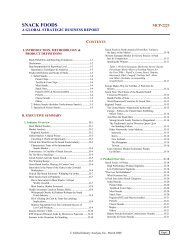the RUSSIA oil & gas competitive intelligence report - Report Buyer
the RUSSIA oil & gas competitive intelligence report - Report Buyer
the RUSSIA oil & gas competitive intelligence report - Report Buyer
You also want an ePaper? Increase the reach of your titles
YUMPU automatically turns print PDFs into web optimized ePapers that Google loves.
Russia Oil and Gas Competitive Intelligence <strong>Report</strong> 2010<br />
9.6mn tpa of LNG and around 900,000b/d of crude <strong>oil</strong>. As of December 2006 Sakhalin Energy is majority<br />
owned by Gazprom (50% plus one share) alongside former majority owner Shell (27.5% minus one<br />
share), Mitsubishi (12.5%) and Mitsui (10%). Gazprom paid US$7.45bn for its majority stake. Roughly<br />
two-thirds of Sakhalin-II’s LNG exports will be exported to nine utilities in Japan, while <strong>the</strong> remaining<br />
third goes to South Korea and North America.<br />
In March 2009, Osaka Gas signed an SPA to buy 200,000tpa of LNG from Sakhalin-II from 2011<br />
without disclosing <strong>the</strong> financial terms.<br />
Wintershall – Summary<br />
BP – Summary<br />
Wintershall is an upstream subsidiary of German chemical group BASF. The company has two major<br />
projects in Russia. The first, <strong>the</strong> US$3bn Yuzhno (South) Russkoe <strong>gas</strong> project, holds recoverable natural<br />
<strong>gas</strong> reserves of more than 600bcm, and reach plateau production rate of 25bcm per annum in mid-2009.<br />
The companies have a preliminary agreement in place to supply over 800bcm of <strong>gas</strong> to Europe to 2043<br />
through BASF’s distribution arm Win<strong>gas</strong>. The second project is <strong>the</strong> US$1bn Achimgaz JV in <strong>the</strong> Yamal-<br />
Nenets region, in which Gazprom and Wintershall are equal partners. It came onstream in July 2008 and<br />
produced around 1bcm and 6,000b/d of condensate in 2009 and is expected to peak at 7.5bcm and<br />
55,000b/d of condensate. The project’s lifespan is put at over 40 years.<br />
BP's presence in Russia is now concentrated on <strong>the</strong> TNK-BP JV, with <strong>the</strong> British major pulling out of <strong>the</strong><br />
CPC pipeline consortium and significantly reducing its Sakhalin exposure. BP has been active in Sakhalin<br />
since 2006, when it launched a 49:51 JV with Rosneft to develop Sakhalin-IV and -V areas in <strong>the</strong> Sea of<br />
Okhotsk. The most promising acreage in Sakhalin-IV was thought to be <strong>the</strong> West Schmidt Block, with<br />
reserves estimated at up to 3bn bbl of <strong>oil</strong> and 255bcm of <strong>gas</strong>. Two exploration wells were drilled at <strong>the</strong><br />
Medved and Toiskaya structures in 2007 but both disappointed. Following extensive interpretation of<br />
seismic data, BP appears to have decided that <strong>the</strong> block holds little commercial prospects and in March<br />
2009 abandoned <strong>the</strong> Sakhalin-IV project.<br />
In February 2010, BP and Rosneft also relinquished <strong>the</strong> East Schmidt Block at Sakhalin-V. BP and<br />
Rosneft said that after evaluating extensive seismic data <strong>the</strong>y decided not to proceed to <strong>the</strong> drilling phase,<br />
again owing to poor commerciality. The JV, however, has chosen to keep <strong>the</strong> o<strong>the</strong>r permit in <strong>the</strong><br />
Sakhalin-V project, <strong>the</strong> Kaigansky-Vasuykanskiy (KG) Block. The partners drilled two deepwater wells<br />
at KG in 2006 and have been sufficiently encouraged by <strong>the</strong> results to shoot more seismic data in 2010 in<br />
preparation for fur<strong>the</strong>r drilling. Estimated reserves at <strong>the</strong> only certified discovery at <strong>the</strong> block, dubbed <strong>the</strong><br />
Kaigansko-Vasyukanskoye Sea field, are put at 118mn bbl of <strong>oil</strong> and condensate (ABC1).<br />
With all synergy between Sakhalin-IV and Sakhalin-V now lost, any commercial discoveries at <strong>the</strong> KG<br />
block are most likely to be developed in conjunction with <strong>the</strong> Sakhalin-III project fur<strong>the</strong>r south.<br />
© Business Monitor International Ltd Page 59









